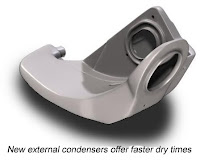
The success of the new concept washer vaulted Bendix Home Appliances to the top of the appliance heap; peaking in 1950 when Bendix commanded an industry-leading $12 million in sales. However, the success of the Bendix washer was short-lived.
Soon other appliance manufacturers introduced cheaper top loading machines that were less efficient and offered a lower price tag. With modern aqueducts bringing copious amounts of water to the west and powerful new clothes dryers available in most new homes, water use and drying time no longer significantly impacted consumer purchasing decisions.
The United States paid a price environmentally when it abandoned front loading washers in the 1960s. While European appliance manufactures worked to improve the efficiency of horizontal washers, the U.S. residential washing machine market became dominated by top loading machines for over three decades.
New ENERGY STAR clothes washer initiatives in the 1990s finally brought change the appliance industry. Through partnerships with manufacturers and financial incentives for research and development, ENERGY STAR, was able to persuade major appliance makers to redesign, retool and ultimately manufacture a new generation of front loading machines. However, not all ENERGY STAR initiatives have been so successful.

From the beginning, ENERGY STAR allowed appliance manufactures to self test, report and regulate, with predictably poor results. For example, separate efficiency standards for different refrigerator configurations have enabled manufactures to produce side-by-side models that are a significantly less efficient than similar-sized bottom-mount freezer models. Additionally, large 36” inch professional-style refrigerators have been given the ENERGY STAR seal of approval even though they consume an average of 600 KWh of electricity annually.
Cheating has also been a problem. In September 2008, a test by Consumer Reports Magazine found that LG’s French door refrigerator energy usage was 100% higher than what was listed on the government-mandated DOE yellow sticker adhered to the product. LG subsequently apologized for the mishap, paid a fine to the DOE and reimbursed consumers who purchased the product. And although the fridge was not ENERGY STAR rated, it nevertheless demonstrates that some manufactures can’t be trusted to test and publish accurate efficiency data.
Separately, Consumers Reports found that energy efficiency data reported on many refrigerators did not include the use of through-door ice and water dispensers. Assuming that most consumers use this feature, Consumer Reports did efficiency testing with through-door system in operation. The tests showed that the refrigerator models used hundreds more kilowatts of electricity annually than was reported on the yellow energy sticker. Consumer Reports concluded, “if the refrigerators are used as intended, the owners won't save as much electricity as they were led to believe when they purchased the appliance.”
Moving forward:
With the exception of clothes washing machines, ENERGY STAR has failed to systematically change efficiency standards within the appliance industry. ENERGY STAR’s decision to hand efficiency standard development and testing over to manufactures is akin to asking high school students to assign their own homework and grade their own final exams. The results have been predictably below expectations.
If greater efficiency is to be achieved, ENERGY STAR must set its own high standards and challenge appliance manufactures to rise above the bar. In addition, oversight must be done by third party laboratories that don’t have a vested interest in fudging results to meet a desired standard. There are numerous testing facilities that are equipped to test appliances including safely certification firms such as UL and ETL.
New advancements exist that can greatly reduce energy consumption, including advanced insulation for refrigerators and ovens, and more efficient heating elements for cooking appliances and clothes dryers. The technology exists but only ENERGY STAR has the power to push it to market.












